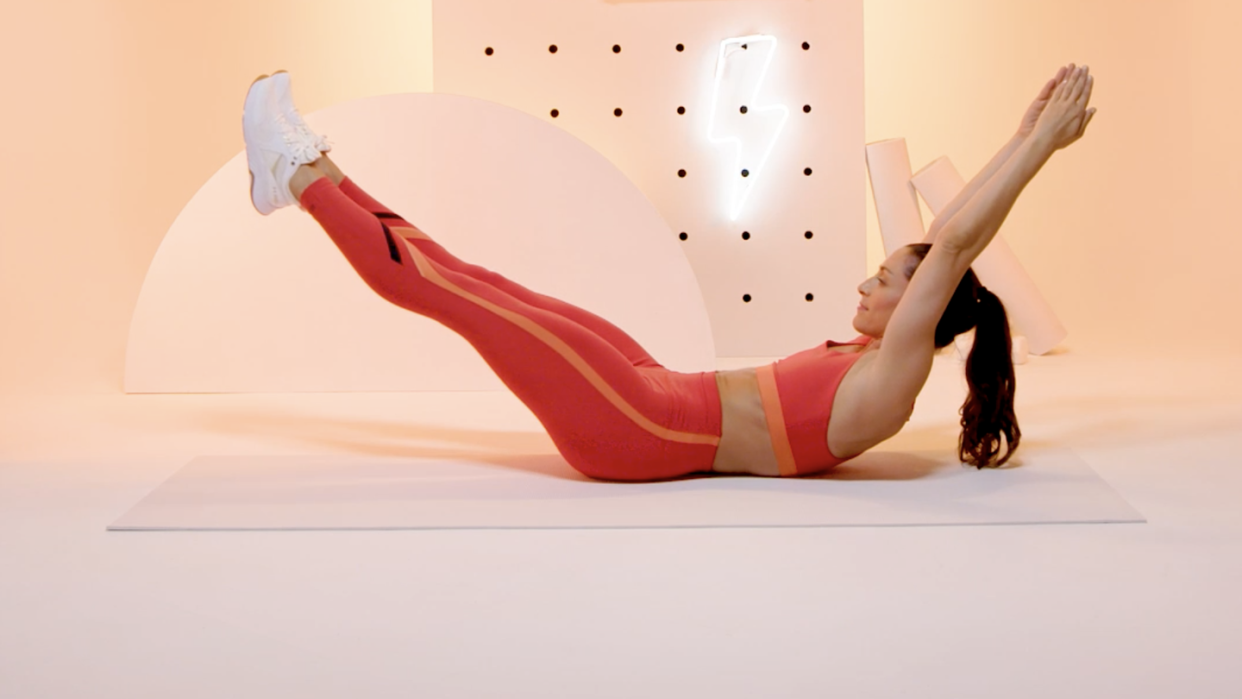You'll Sculpt Your Upper Abs Like Crazy With This 20-Minute Workout

Building a strong core is no walk in the park, but if you’re ready to spice up your abs workouts, you’ve come to the right place. Training your entire midsection is worth the time to keep your core strong and prevent injury—but upper ab-focused workouts deserve a spot in your busy schedule.
“Training your upper abs (the six-pack muscles) is important because it's an essential portion of your core that is in charge of bending and straightening the torso," says Danyele Wilson, CPT, an EvolveYou trainer. “From a performance standpoint, training your upper abs and obliques will help you develop a strong and stable core which keeps your spine neutral during big lifts, and allows you to transfer power between the lower and upper half more efficiently."
You can't truly isolate your upper abs from your lower abs (when you engage your core, you'll naturally work both!), but exercises that bring the chest to the pelvis or rib cage down to the hips are going to especially engage the upper abs, says Wilson. In fact, upper abs are actually the most frequently targeted muscles when training core due to the large surface area, she adds.
The following exercises in this upper ab workout strengthen your entire core (it's all connected!), but they'll especially fire up that top half of your rectus abdominis and help achieve that six pack goal, if that's on your list.
Meet the experts: Danyele Wilson, CPT, is a certified personal trainer and EvolveYou trainer. Jacqueline Kasen, CPT, is a Miami-based coach, master trainer, and senior director of group fitness at Anatomy.
Benefits Of Strengthening The Upper Abs
Improved core stability. Strengthening the upper abs helps enhance core stability since the rectus abdominis plays a crucial role in stabilizing the spine and maintaining proper posture, says Jacqueline Kasen, CPT, a Miami-based coach, master trainer, and senior director of group fitness at Anatomy. Plus, not only does core stability support everyday movements, but it also reduces the risk of lower back pain and injuries, she adds.
Enhanced athletic performance. The upper abs are involved in just about every athletic activity such as running, jumping, and throwing, says Kasen. “By strengthening these muscles, you can generate more power and force, leading to improved performance in physical activities.”
Better posture. Weak upper abs often result in poor posture and spinal misalignment, but by targeting these muscles, you can correct postural imbalances, reduce strain on the lower back, and promote a more upright and aligned posture, says Kasen.
Functional strength. Strong upper abs are essential for performing daily activities and tasks that involve core engagement such as lifting objects, carrying groceries, or even sitting up from a lying position, says Kasen. As a result, developing the upper abs improves functional strength, making these activities easier, and reducing the risk of strain or injury, she adds.
Anatomy Of The Upper Abs
Rectus Abdominis
When you think of a six-pack, you’re likely referring to the appearance of the rectus abdominis, says Kasen. But its primary function is to flex the spine, bringing the ribcage closer to the pelvis, so you have the ability to bend forward and curl up, she explains.
Internal And External Obliques
The main function of your obliques is to assist in trunk rotation and lateral flexion, says Kasen. For example, twisting from left to right and bending side to side.
Transverse Abdominis
The transverse abdominis is the deepest abdominal muscle that’s responsible for core stability, says Kasen. These muscles wrap around the waist like a corset to support and protect the spine.
Best Upper Abs Workout
Time: 20–25 minutes | Equipment: mat, light weight (optional) | Good for: core
Instructions: Complete three or four rounds of the following four circuits. Perform each exercise for 30 seconds, then immediately continue to the next exercise in the circuit. Once you’ve completed the circuit, rest for 15 to 30 seconds, then repeat two or three more times. At the end of each circuit, rest for 60 seconds and proceed to the next circuit. Repeat until finished.
Do planks work the upper abs?
Yes! Planks are an excellent exercise to target and strengthen the upper abs, says Kasen. On top of that, planks also engage the arms, hips, glutes, legs, and upper back, so you get a major bang for your buck.

How often should you do upper ab workouts to see definition?
Generally speaking, training your upper abs two to three times a week is best for optimal results, says Kasen. That said, your current goals, training programming, and diet will also play a role in ab definition, she adds.

Should you work your upper abs every day?
Believe it or not, training your upper abs every day is not going to lead to quicker results, says Kasen. “It’s not recommended to work the same muscle group every day as it needs time to repair and recover, and it’s more effective to work on them about two to three times a week.”

You Might Also Like

